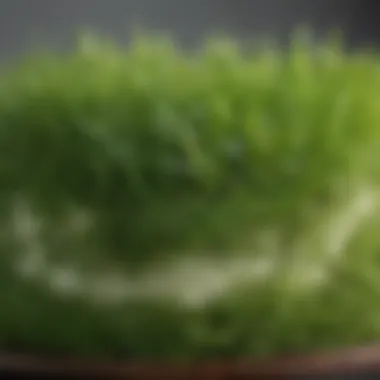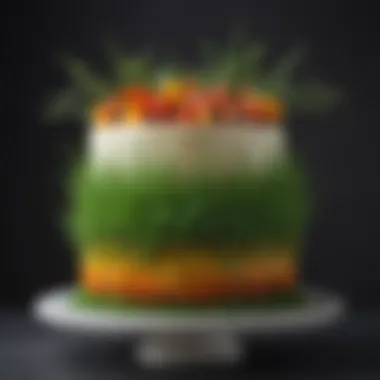Innovative Cake Decorating with Edible Grass


Intro
The culinary world constantly evolves, with new trends reshaping traditional practices. One such innovation involves edible grass in cake decorating. This intriguing ingredient is a departure from conventional decoration techniques, drawing the interest of both novice and experienced bakers alike. Edible grass not only enhances the visual appeal of cakes but also adds a unique flavor profile and nutritional benefits.
In this guide, we will examine the various facets of using edible grass in cake decorating. From understanding its aesthetic advantages to exploring practical applications, each section will provide essential insights for those seeking to elevate their cake designs. Accordingly, we will address key types of edible grass, sourcing considerations, and techniques for incorporating it seamlessly into your creations.
Through this exploration, cake decorators can harness the creative potential of edible grass, allowing for artistic expression in their work. This article aims to inspire culinary artists by showcasing the versatility of this unique ingredient and providing practical tips for successful implementation.
Prelude to Edible Grass
Edible grass in cake decorating is an emerging trend that challenges conventional dessert aesthetics. The use of grass not only enhances the visual appeal of cakes but also contributes unique flavors and nutritional benefits. As culinary arts evolve, integrating unexpected elements like edible grass can set a cake apart. This section highlights the relevance of edible grass, exploring how it can transform a simple cake into a vibrant centerpiece. Understanding the fundamentals of edible grass is vital for both professional decorators and home bakers.
Definition and Overview
Edible grass refers to various grass species that are safe for human consumption. Common examples include wheatgrass, barley grass, and oat grass. These grasses offer distinct flavors, textures, and visual properties that can enhance the aesthetic and nutritional value of cakes. In a culinary context, edible grass can be used fresh, dried, or as a powdered form, depending on the decoration style and desired impact. The versatility of edible grass makes it suitable for various decorations, including garnishes, natural designs, or even integrated into the cake mixture.
Historical Context
The tradition of using plants and herbs in cuisine is far from new. Various cultures have historically incorporated greenery into their dishes for flavor and decoration. In recent years, there has been a resurgence of interest in these natural elements, particularly among health-conscious consumers. The modern culinary movement, focused on sustainability and organic ingredients, aligns perfectly with using edible grass. This makes edible grass not only a nod to tradition but also a reflection of contemporary gastronomic values. Through time, as the culinary landscape changes, edible grass remains a relevant choice for innovative decorators looking to push boundaries in cake design.
Types of Edible Grass
Understanding different types of edible grass is crucial in cake decorating. Each variety offers unique flavors, textures, and nutritional benefits. Using the correct type of grass can enhance not only the visual appeal of a cake but also its health benefits. This section discusses four popular types of edible grass often utilized in culinary creations: wheatgrass, barley grass, rye grass, and oat grass.
Wheatgrass
Wheatgrass is a youthful plant of the wheat family. It is revered for its high chlorophyll content and vibrant green color. In cake decorating, wheatgrass can be used either as a garnish or blended into batters for additional nutrients and color. Its distinct taste is slightly sweet but grassy, which compliments many flavors. Additionally, wheatgrass is rich in vitamins A, C, and E, making it a nutritional powerhouse. Some bakers use it for its detoxifying properties as well. When sourcing wheatgrass, fresh options are preferred since they offer the best flavor and nutritional value.
Barley Grass
Barley grass is another noteworthy type of edible grass. It has a milder flavor compared to wheatgrass, often described as sweet with a hint of nuttiness. This makes it versatile in various dessert applications. When used in cakes, barley grass can subtly enhance the flavor without overpowering other key ingredients. It is packed with antioxidants and dietary fiber, contributing to its appeal in health-conscious baking. Many decorators use barley grass as a topping, providing a refreshing contrast to sweeter elements in the cake.
Rye Grass
Rye grass is not the first option that comes to mind for cake decorating, but its unique characteristics should not be overlooked. This grass has a more robust flavor that can add depth to certain cake combinations, especially those involving earthy or spiced ingredients. Rye grass is known for its rich content of B vitamins and minerals, which aid in overall health. Incorporating rye grass into cake designs involves careful consideration of balance, as its strong flavor can dominate. It is best utilized in themed cakes where its taste can shine, such as rustic or harvest motifs.
Oat Grass
Oat grass is the least common in cake decorating but merits attention for its subtle taste and creamy texture. It has a light sweetness, making it suitable for cakes that require a gentle touch. Oat grass also provides several health benefits, including vitamins and minerals, and is known for its soothing properties. Decorators often use oat grass in delicate floral arrangements on cakes, as its gentle coloring and texture work well with lighter themes. This variety can help achieve the desired aesthetic without overwhelming the overall flavor profile of the dessert.
Each type of edible grass brings different elements to culinary designs, making them important tools in the decorator's arsenal.
Nutritional Benefits
The inclusion of edible grass in cake decorating is not merely an aesthetic choice; it also brings a myriad of nutritional advantages. Consumers nowadays are increasingly health-conscious and look for ways to incorporate wholesome ingredients into their diets. Edible grass, such as wheatgrass and barley grass, is packed with essential vitamins, minerals, and antioxidants. Thus, integrating these greens into cake designs can enhance both the visual appeal and nutritional value of the baked goods. This section delves deeper into the various nutritional aspects that edible grass adds to cakes.
Vitamins and Minerals Content
Edible grass varieties are rich in vitamins and minerals which are fundamental for maintaining good health. For example, wheatgrass contains vitamins A, C, and E, each playing a crucial role in immune function and skin health. Similarly, barley grass is an excellent source of folate, which is vital for DNA synthesis and repair.


Other notable nutrients include:
- Vitamin K: Present in several types of edible grass, it supports bone health and aids in blood clotting.
- Calcium: Important for maintaining strong bones and teeth, it’s also found in barley and wheatgrass.
- Iron: Necessary for transporting oxygen in the blood, helping to prevent anemia.
This vitamin and mineral content makes edible grass a potent addition to baked items, promoting overall health while pleasing the palate.
Antioxidant Properties
Edible grasses also boast impressive antioxidant properties. Antioxidants combat free radicals in the body, reducing oxidative stress and lowering the risk of chronic diseases. For example, barley grass has been studied for its high antioxidant capacity, which comes from compounds like superoxide dismutase and chlorophyll.
Incorporating antioxidants into cakes can offer you and your clients a health boost. Some health benefits include:
- Reducing inflammation: This can help alleviate various conditions such as arthritis.
- Supporting brain health: Antioxidants can protect brain cells from damage, potentially lowering the risk of neurodegenerative diseases.
- Improving skin health: By combating harmful agents, antioxidants can promote youthful skin, making cakes not just a treat but a beauty booster.
Potential Health Benefits
The potential health benefits of consuming edible grass extend beyond just nutritional values. Researchers have pointed out multiple positive effects associated with the regular intake of these greens. While individual results may vary, the overall picture indicates that edible grass can make a significant contribution to one's health. Potential benefits include:
- Digestive health: Grass contains dietary fiber which aids digestion and may help in regular bowel movements.
- Detoxification: Edible grass can support the liver in detoxifying the body, thus breaking down harmful substances.
- Weight management: Low in calories yet high in nutrients, edible grasses can be a helpful component for those monitoring their weight.
Practical Considerations
When incorporating edible grass into cake decorating, practical considerations are crucial. These aspects ensure the quality and effectiveness of using edible grass in culinary designs. Understanding the right sourcing, preparation, and handling techniques can significantly affect the outcome and acceptance of the decorated cakes.
Sourcing Quality Edible Grass
The first step in utilizing edible grass is finding high-quality sources. Not all grass varieties are suitable for consumption, and the difference in quality can influence flavor and safety. Farmers’ markets, specialty health food stores, and online suppliers are typically the best options. Always prioritize organic sources to avoid pesticides and harmful chemicals. Additionally, look for grass that appears vibrant and fresh. The texture and smell can also indicate quality. Make sure to check labels for certification to ensure safety.
- Local Farming: Engage with local farmers who grow edible grass varieties. This direct connection often results in fresher produce.
- Online Suppliers: Websites specializing in organic food can offer a wider range of varieties, sometimes including seasonal options.
- Health Food Stores: Chains and specialty shops often stock edible options, ensuring both availability and quality.
Cleaning and Preparing Edible Grass
Once sourced, cleaning and preparing edible grass is essential for reducing contamination risks and enhancing taste. Begin by rinsing the grass gently under cold water to remove any dirt or debris. This step is critical as residues can affect the flavor profile and overall safety of the finished cake. After rinsing, pat the grass dry with a clean paper towel or cloth to avoid excess moisture.
- Trimming: Remove any tough stems or discolored parts to ensure only the most palatable elements are used in decoration.
- Chopping: Depending on the cake design, consider finely chopping the grass for integration into mixtures or keeping it in longer strands for aesthetic appeal.
- Storage: If not used immediately, store cleaned grass in a breathable container in the refrigerator. This management can prolong freshness until it is ready for decoration.
"Adhering to cleanliness ensures a safe and delicious outcome in cake decorating with edible grass."
In summary, prioritizing quality sourcing and meticulous preparation will yield the best results when using edible grass in cake decorating. Proper practices not only enhance flavor but also contribute to a visually appealing presentation.
Techniques for Cake Decoration
Incorporating Edible Grass into Designs
Incorporating edible grass into cake designs can elevate the visual appeal tremendously. The first step is selecting the right type of edible grass that complements the overall theme of the cake. For example, wheatgrass has a vivid green color and can create a refreshing look, while barley grass provides a softer, muted tone.
There are various methods to add edible grass:
- Garnishing: Use freshly cut strands to sprinkle atop frosting.
- Embedding: Gently fold grass into cake batter for a unique texture and flavor profile.
- Utilizing as Decor: Arrange dried or fresh grass in patterns or shapes to outline cake layers.
Understanding the balance between flavors is important. Edible grass should not overpower the cake but complement the existing flavors. This approach ensures that each bite offers an exciting experience.


Creating Grass-Focused Themes
A theme centered around grass can evoke feelings of freshness and connection to nature. When creating grass-focused cake themes, consider the following elements:
- Color Palette: Use greens and earthy colors to enhance the natural feel. White or pastel tones can serve as a solid base, allowing the grass to stand out.
- Complementary Ingredients: Pair grass with flavors such as lemon, mint, or honey. These flavors align well and enhance the freshness of the grass.
- Presentation: Use grass as the main focus to create a visually striking centerpiece. A cake decorated with grass alongside small edible flowers can present a beautiful garden scene.
Branding cakes with themes can also appeal to target audiences, such as healthy eaters or those interested in sustainability.
Layering Techniques
Layering is a crucial part of cake decoration, giving depth and dimension. When using edible grass, layering can be approached in multiple ways:
- Horizontal Layers: Incorporate layers of cake with grass-infused frosting between them. This can be visually appealing and adds a distinct texture.
- Vertical Layers: Use strips of grass to create vertical lines or sections, providing visual interest. Layers of different colors of frosting can enhance this effect further.
- Height Variations: Create varying heights in decoration by stacking grass in certain areas. This adds a three-dimensional aspect to the cake.
Each method allows decorators to experiment while ensuring that the edible grass is a cohesive part of the design. Ultimately, mastering these techniques enhances the overall experience, making each cake a delightful centerpiece.
"The use of edible grass challenges cuisine norms and invites creativity into cake decorating, offering fresh perspectives on presentation and flavors."
In summary, utilizing edible grass in cake decoration involves embracing innovative techniques that combine aesthetics with taste. As one develops skills, the integration of edible grass will undoubtedly lead to exciting culinary outcomes.
Challenges and Limitations
The adoption of edible grass in cake decorating does not come without its challenges. While the unique aesthetic and nutritional benefits are significant, decorators must also navigate several limitations. Addressing these challenges is crucial for achieving the desired effects in cake design while ensuring consumer satisfaction and product integrity. Understanding these limitations helps decorators make informed decisions that enhance both the quality and creativity of their offerings.
Shelf Life and Freshness
One of the most significant challenges when using edible grass in cake decorating is its shelf life. Unlike traditional cake decorations, edible grass is perishable. As it loses freshness, it can affect the overall appearance and taste of the cake. Most edible grass, such as wheatgrass and barley grass, has a shelf life of only a few days, especially when not stored properly. It is important for decorators to implement effective storage methods to maintain both freshness and visual appeal.
To combat this issue:
- Refrigerate edible grass to prolong its freshness.
- Use it as a decoration close to the time of serving.
- Consider using dehydrated or freeze-dried options, which may offer longer shelf life compared to fresh varieties.
Texture Compatibility
Another limitation relates to texture compatibility. Edible grasses can have a fibrous texture that diverges from the soft or creamy components typically expected in cakes. This contrast can create a disjointed eating experience. When incorporated improperly, the texture of the grass might be unappealing to some consumers.
To ensure a pleasant experience:
- Pair edible grass with complementary textures. For example, combine it with creamy frostings or softer cake layers.
- Test different preparation methods, such as blending grass into a puree for smoother incorporation.
- Be mindful of how the texture interacts with other cake components, ensuring a cohesive mouthfeel.
Consumer Acceptance
Finally, the successful use of edible grass in cake decoration hinges on consumer acceptance. Some individuals might be hesitant about consuming grass due to preconceived notions or unfamiliarity. It is essential for decorators to educate consumers about the health benefits and culinary potential of edible grass.
Strategies to improve consumer acceptance include:
- Clearly label cakes that feature edible grass to inform customers about its presence and benefits.
- Host tastings to allow potential customers to experience the flavor and texture.
- Share informative content on social media or websites, elucidating the nutritional advantages.
"Consumer education is key. The more information provided, the more likely individuals are to embrace new ingredients in their food."
Case Studies and Examples


Understanding Case Studies and Examples is crucial in highlighting the practical application of edible grass in cake decorating. These sections serve to illustrate real-life applications, revealing not just the aesthetic benefits but also the creativity and culinary innovations that can arise. Each example sheds light on the diverse possibilities when integrating edible grass into cakes, informing decorators about the tangible outcomes of their designs. This can inspire both novice and advanced cake decorators, providing a reference point for their own artistic endeavors.
Notable Edible Grass Cakes
When discussing notable edible grass cakes, many exceptional creations have caught the eye of culinary enthusiasts. One such example is the cake adorned with wheatgrass and set in a natural theme, which vividly showcases the verdant hues that edible grass can bring. Such a cake not only appeals to the eyes but also offers a hint of earthiness, merging art with nutrition.
A standout instance involved a wedding cake layered with barley grass, evoking a lush garden atmosphere. The use of barley's vibrant green strands provided both texture and a fresh flavor that complemented the cake's sweetness. Attention to detail like this proves how fine the line is between visual appeal and taste.
Other creations worth mentioning include intricate dessert sculptures where rye and oat grass were audaciously intertwined, creating a textural masterpiece that captivated guests. As decorators push the limits, the results speak to the innovative nature of using edible grass.
Innovation in the Culinary Arts
Innovation in the culinary arts is decidedly forward-thinking, particularly when it comes to edible grass. Chefs and decorators have sought out new methods for incorporating this ingredient, ranging from incorporating grass juice into cake batters to using dehydrated grass powder for flavor enhancements. Some have even begun to explore hydrocolloids with edible grass, finding ways to enhance sustainably sourced ingredients with modern techniques.
These creative approaches not only enhance taste and presentation but also accommodate different dietary preferences. For example, a concoction integrating oat grass into a gluten-free cake offers not just a dessert option for those with restrictions but also an opportunity for heightened nutritional value.
Another innovative practice includes edible-themed events where participants are encouraged to use edible grass in their designs while competing, thus elevating cake artistry as a whole. Such events create a community where artistic expression through edible grass is not merely a task but a celebrated skill.
"The integration of edible grass into cake decorating transforms not just the culinary experience, but enriches the artistry itself."
Thus, case studies and examples serve to solidify the significance of edible grass, demonstrating its versatility and its alignment with contemporary culinary trends.
Future of Edible Grass in Cake Decorating
The exploration of edible grass in cake decorating opens a door to innovative culinary landscapes. This section focuses on what lies ahead for this unique trend within the food industry. As more pastry chefs and bakers seek to differentiate their offerings, edible grass emerges not just as a novelty, but as a legitimate ingredient that brings aesthetic and nutritional benefits to cake designs.
The future of edible grass in cake decorating is marked by increasing interest in natural ingredients. Consumers are more aware of their food choices and demand transparency in what goes into their desserts. By incorporating edible grass, decorators can engage this evolving marketplace. Benefits include enhanced taste profiles, added visual appeal, and a range of health advantages. Such attributes position edible grass as an advantageous choice for those crafting cakes.
Another important consideration is the potential for innovation in flavor and presentation. As decorators experiment with different types of edible grass, we are likely to see more creative applications that go beyond traditional uses. These practices may influence how cakes are presented, allowing for a new form of expression within cake art that harmonizes taste and aesthetic value.
Emerging Trends
In recent years, the culinary world has seen a gradual shift toward plant-based and holistic food sources. Emergence of edible grass in cake decoration is not just a trend but represents a broader embrace of natural elements. Here are some key trends in this area:
- Floral and Grass Combos: Combining edible grass with edible flowers to enhance aesthetics and flavor.
- Color Variations: Use of varied colors in edible grasses can inspire many unique designs, allowing decorators to create visually stunning cakes.
- Health-Conscious Options: With many consumers seeking healthier alternatives, the incorporation of grasses known for their nutrients can appeal to this market.
- Interactive Decor: Some pastry chefs are beginning to offer cake designs that include elements like live grass, creating experiences where involvement is encouraged.
These emerging trends suggest a vibrant future for edible grass in the realm of cake decorating. Chefs are likely to continue pushing boundaries, using this unique ingredient to craft personalized, health-oriented desserts.
Sustainability Practices
Sustainability is an increasingly critical aspect of any food practice. The use of edible grass can align well with sustainable baking practices, as many types of grasses can be sourced locally or grown easily in home gardens. Here are practical ways that sustainability can be incorporated into cake decorating:
- Local Sourcing: Bakers can support local farmers by sourcing edible grass, reducing the carbon footprint associated with transportation.
- Minimal Waste: Grasses can be used in various ways, from decoration to edible components, minimizing waste in the baking process.
- Organic Practices: Many edible grasses are grown organically, which aligns with consumer preferences for pesticide-free ingredients.
- Education and Awareness: Educating consumers about the benefits of edible grass and sustainable practices can foster a community that values local and healthy food options.
Epilogue
Summary of Key Points
In this article, several critical aspects regarding edible grass have been discussed:
- Definition and Types: Edible grass varieties, such as wheatgrass and barley grass, offer unique flavors and textures that can elevate cake designs.
- Nutritional Benefits: These grasses are rich in essential vitamins and antioxidants, offering both health benefits and culinary appeal.
- Practical Techniques: Techniques for using edible grass, including sourcing, cleaning, and decoration methods, provide essential guidance for decorators.
- Challenges: Issues regarding freshness, texture compatibility, and consumer acceptance have been highlighted, encouraging cautious innovation.
- Future Directions: Emerging trends and sustainability practices suggest a promising path for the integration of edible grass in future cake designs.
Emphasizing these points reinforces how edible grass can transform traditional cake making into a multifaceted culinary endeavor.
Final Thoughts on Edible Grass
"Reimagining cake design through edible grass not only creates visual impact but also embraces a health-conscious approach to dessert-making."
Recommendations for those interested in this art would include trying a variety of grasses, seeking fresh ingredients, and considering consumer tastes to ensure successful applications in their culinary creations.















